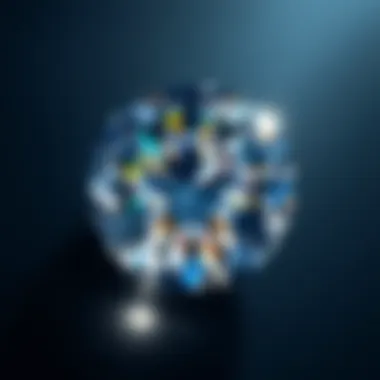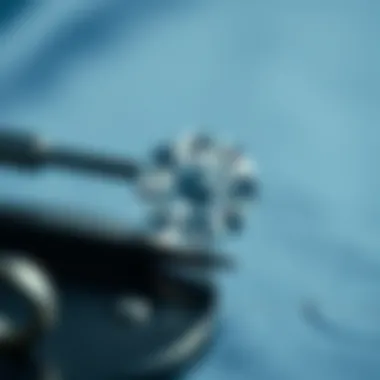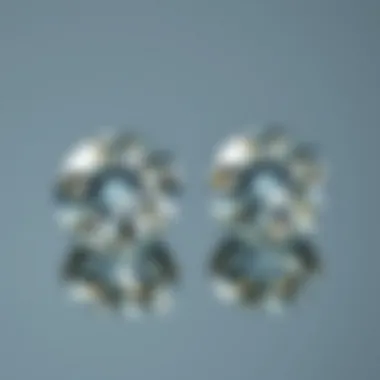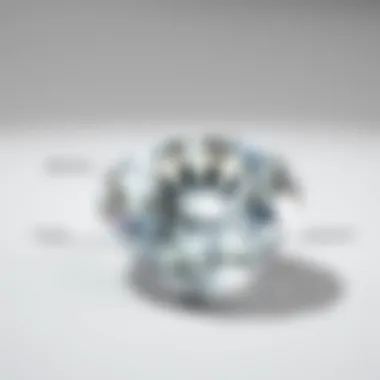Identifying Authentic Diamonds: A Comprehensive Guide


Intro
When it comes to precious stones, few can evoke the same awe and admiration as diamonds. Their multifaceted brilliance and rarity have captivated humans for centuries. Yet, amidst this allure lies a growing concern—how to accurately distinguish between authentic diamonds and their imitations. As gem enthusiasts, collectors, and jewelry designers dive into the sparkling world of diamonds, understanding this crucial distinction becomes paramount.
Uniquely defined by their carbon composition and extraordinary hardness, diamonds present a specific set of characteristics that can be analyzed. The market is flooded with faux alternatives, from cubic zirconia to moissanite, complicating the purchase process for even the most seasoned collectors. Thus, having a keen eye for identifying genuine diamonds not only protects investments but also enriches our knowledge of these remarkable natural wonders.
In the following sections, we will delve into the essential attributes of diamonds, explore various testing techniques available to both professionals and novices alike, and highlight important considerations regarding the environment and ethical sourcing. Armed with this knowledge, readers will be better equipped to navigate the diamond landscape, ensuring informed choices and deepening their appreciation for these exquisite gems.
Understanding Diamonds
Understanding diamonds is not simply an academic exercise; it’s a journey into the heart of one of nature's most awe-inspiring creations. This section lays the groundwork for all that follows in the guide, tapping into the mineral’s complexity and allure. By grasping the geological formation and intrinsic characteristics of diamonds, enthusiasts and professionals alike can make well-informed decisions.
Knowing what defines a diamond, particularly the aspects that separate natural diamonds from their imitations, can be the difference between making a worthwhile investment or falling prey to clever marketing.
The Geological Formation of Diamonds
Diamonds are formed under tremendous pressure and heat deep within the Earth’s mantle. They are composed of carbon atoms arranged in a crystal lattice structure, which gives them their exceptional hardness and brilliance. Over billions of years, conditions in the mantle allow these carbon atoms to crystallize into diamonds. The geological processes, including volcanic eruptions, transport these precious stones closer to the Earth’s surface. Understanding this formation process not only enhances appreciation for diamonds but also reinforces the rarity of natural stones.
"A genuine diamond can take millions of years to form, making each piece imbued with a sense of ancient history."
Characteristics of Natural Diamonds
Diamonds come with a unique set of characteristics that define their quality and value. The four key characteristics are clarity, cut, color, and carat weight. Each plays a vital role in determining a diamond's overall appeal and marketability. For both collectors and jewelry designers, familiarity with these attributes is crucial for making informed choices.
Clarity
Clarity refers to the presence of internal or external flaws, known as inclusions and blemishes, respectively. A diamond with high clarity will be visually striking, allowing maximum light to pass through and reflect, producing unparalleled brilliance. The higher the clarity grade, the rarer the diamond tends to be.
High clarity is often considered a top priority among gem enthusiasts, as these stones are not only visually stunning but also retain their value well over time. However, clarity has its pitfalls; a focus solely on clarity without considering cut or color could lead to a superficial assessment of a diamond's overall worth.
Cut
The cut of a diamond refers to how well it has been shaped and faceted. A well-cut diamond will exhibit superior light performance, meaning it reflects and refracts light beautifully. Excellent cut grades can elevate a diamond’s perceived brilliance more than other characteristics, making it arguably the most essential element of all.
However, achieving the perfect cut involves a delicate balance. Too deep or too shallow a cut, and the diamond might lose its sparkle. Thus, understanding the nuances of cut can greatly enhance evaluations during purchases.
Color
The color of a diamond, measured on a scale from D (colorless) to Z (light yellow or brown), impacts its value largely. Colorless diamonds are generally the most sought-after, reflecting a level of purity rarely found. Yet, there are colored diamonds, such as blue and pink, that possess their unique allure and market demand.
While a high color grade signifies higher desirability, one should consider personal taste and aesthetic demands, as beauty often lies in subjective judgment.
Carat Weight
Carat weight indicates the size of the diamond. A carat equals 200 milligrams. Larger diamonds typically command higher prices, but not exclusively—clarity, cut, and color must also be factored into the valuation.
A common misconception is assuming that a larger carat weight automatically equals a better diamond. In reality, smaller, high-quality diamonds are often more desirable than larger, flawed stones. Understanding this aspect emphasizes the notion that carat weight, while significant, should be complemented by quality in other characteristics for a well-rounded assessment.
Types of Diamond Imitations
When diving into the world of diamonds, understanding the types of diamond imitations is crucial. This knowledge aids buyers in navigating the bustling market and avoiding potential pitfalls. Many folks may think they’re getting the real deal, only to find out that what they possess differs from natural diamonds. Thus, familiarizing oneself with these imitations ensures informed purchasing decisions, ultimately safeguarding investments in this precious gemstone.
Synthetic Diamonds
Synthetic diamonds are created in controlled environments, replicating the natural process that happens deep within the Earth. These diamonds possess the same physical and chemical properties as their natural counterparts, making them quite challenging to distinguish without advanced techniques. The key appeal of synthetic diamonds lies in their cost-effectiveness; they are typically priced up to 30% lower than natural diamonds while retaining significant beauty and durability. Moreover, most synthetic diamonds can be traced back to specific manufacturers, which raises consideration for buyers who value traceability in their purchases.
Simulants and their Differences


Simulants are designed to mimic the appearance of genuine diamonds but are fundamentally different materials. They can mislead even the sharpest of eyes, which is why discerning the variations among them is vital. The most common simulants include Cubic Zirconia, Moissanite, and a range of other imitations, each with unique characteristics.
Cubic Zirconia
Cubic Zirconia (CZ) is one of the most widely-known diamond simulants, often praised for its affordability and stunning brilliance. It’s heavier than a diamond, which can become a distinguishing factor during an inspection. The primary reason CZ enjoys popularity is its dazzling fire and clarity, which can make it appear almost indistinguishable from real diamonds at a glance. However, its relative softness—around 8.5 on the Mohs scale—means that it can scratch more easily than a diamond, which sits at a hardness of 10. This intrinsic property makes Cubic Zirconia an appealing choice for fashion jewelry, where the goal is to dazzle without breaking the bank.
Moissanite
Moissanite, initially discovered in a meteorite, has gained traction in the gemstone community as a diamond alternative. Its key characteristic is its incredible brilliance, often surpassing that of natural diamonds. It scores a solid 9.25 on the Mohs scale, which makes it durable enough for daily wear. For many, Moissanite's unique optical features, like its fiery dispersion and less traditional look, make it a popular choice for engagement rings and other fine jewelry. Nonetheless, its notable color range can swing from colorless to slightly tinted, making it essential for buyers to examine the individual stone carefully in different lighting.
Other Imitations
Beyond Cubic Zirconia and Moissanite, there are various other imitators worth mentioning. These include glass, white sapphire, and even some resin-based options that can look good from a distance but quickly reveal their true nature under scrutiny. Glass, for instance, may sparkle but lacks the durability and refractive qualities that diamonds possess, making it unsuitable for long-term jewelry pieces. On the other hand, white sapphire can be an attractive option but may not possess the same optical brilliance that one typically associates with diamonds. Each of these alternatives offers its own set of pros and cons, so buyers should weigh their options carefully.
Understanding these diamond imitations not only aids in making educated choices but also enriches the overall appreciation for gemstones.
In essence, being aware of synthetic diamonds and various simulants offers valuable insight for anyone eager to navigate the intriguing world of diamonds, ensuring what you buy is truly worth every penny.
Assessment Techniques
When it comes to discerning genuine diamonds from imitations, assessment techniques play a pivotal role. These methods not only aid in a thorough evaluation of a diamond's authenticity, but also help buyers avoid costly mistakes in their purchases. A comprehensive understanding of various assessment techniques—such as certification importance, visual inspection methods, and testing tools—enables gem enthusiasts to make informed decisions, ensuring that their investments are not just sparkling rocks, but rather precious, high-quality gemstones.
The Importance of Certification
Certification is your best buddy when it comes to buying diamonds. A reputable certification from organizations like the Gemological Institute of America or the International Gemological Institute guarantees that a diamond has been evaluated by professional gemologists. This certification details the diamond’s characteristics such as cut, color, clarity, and carat weight, and it acts as a trusted source of your purchase.
Importance can't be overstated. Imagine buying a masterpiece only to find out it's a forgery. Certification not only enhances the value of the diamond but also safeguards your investment. It establishes a baseline for discussions about quality, which can be especially crucial in negotiations. When closely dissecting a diamond's certification, the buyer becomes well-informed, minimizing the chances of being taken for a ride in the diamond market.
Visual Inspection Methods
Visual inspection methods are your first line of defense when evaluating a diamond, allowing buyers to gather observable details before relying on more sophisticated tools. This technique primarily involves examining the diamond closely for various attributes like clarity and cut.
Magnification Techniques
Magnification techniques are significant for closely examining the nuances of a diamond. Using tools like jeweler's loupes or microscopes, one can inspect the diamond for inclusions or blemishes that affect its overall quality. What makes this technique excellent is its ability to reveal flaws invisible to the naked eye.
There's a uniqueness to using magnification because it shines a light on authenticity. A higher-quality diamond often has fewer inclusions, setting it apart from lower grades or fake stones. However, while magnification is a beneficial choice, it does require a bit of practice to use effectively. If not used correctly, the results can be misleading, leading to an erroneous conclusion regarding a diamond's quality.
Light Refraction Analysis
Another method is light refraction analysis. This technique examines how light passes through the stone and is a powerful indicator of diamond quality. For a genuine diamond, light will refract beautifully, creating that trademark sparkle. What�’s key here is the brilliance that comes from light interaction, which can differ dramatically with imitations or synthetics.
Light refraction is not just beneficial; it's also straightforward. By simply overturning the stone and observing its interaction with natural light, you might pick up critical clues about authenticity. However, this method does have its limits. Lighting conditions can heavily influence your observations, so it’s always best to combine it with other techniques.
Testing Tools for Diamond Identification
Testing tools are an essential addition to any diamond assessment arsenal. They provide scientific backing to your visual inspections and certifications, offering clarity on whether your diamond is the real deal.
Diamond Tester


A diamond tester operates based on thermal conductivity principles. When applied to a diamond, it efficiently measures how well heat transfers through the stone. Genuine diamonds have a remarkable ability to conduct heat, which is why these testers uniquely identify them.
This tool is not only beneficial but also popular among both amateurs and professionals due to its ease of use. You simply touch the tester to the stone, and results appear promptly. However, keep in mind that while effective, diamond testers can sometimes misread synthetic diamonds. So, it’s best employed alongside other techniques for enhanced accuracy.
Thermal Conductivity Testers
Thermal conductivity testers are an upgraded version of diamond testers. They utilize more advanced technology, providing more precise measurements of heat conduction. This feature is what makes them an invaluable tool in the world of gem assessment.
Using a thermal conductivity tester may yield results with more nuanced data compared to traditional diamond testers. Yet, these testers have a couple of downfalls. They often require batteries or recalibration, making them less portable or reliable in certain situations. Ultimately, while they can be costly, the investment is pivotal for serious gem enthusiasts who want to equip themselves with robust tools for identification.
"When investing in diamonds, knowledge is your best ally, and a suite of assessment techniques will arm you to face this sparkling world with confidence."
Environmental Factors in Identification
When it comes to distinguishing authentic diamonds from their many imitations, environmental factors play a surprisingly crucial role. The surroundings in which a diamond is observed or stored can greatly affect not just the visual aspects of the stone but also the methods employed in its identification. Understanding these factors is essential for anyone looking to make informed decisions regarding diamond acquisitions.
Handling and Storage Considerations
Proper handling and storage practices cannot be overstated. A diamond, despite its hardness, is still susceptible to damage if mishandled.
- Avoiding Scratches: Diamonds can scratch other softer gemstones, which may lead to confusion. Always store your diamond jewelry in a cloth-lined box, separate from other pieces.
- Humidity and Temperature: Extreme humidity can lead to tarnishing in metal settings, while drastic temperature changes can induce unwanted stress on the stone. Finding a balance is key.
- Personal Handling: When showing off a diamond, be sure to hold it by the edges and avoid touching the facets. Fingerprints can cloud its brilliance, thus misleading anyone trying to assess its quality.
By being mindful of how a diamond is stored and handled, enthusiasts can maintain its integrity and clarity, making evaluation more straightforward.
Influence of Lighting Conditions
Lighting can really make or break a diamond's appearance. Natural vs. artificial lighting can yield distinct visual effects, making identification tricky. Understanding these nuances can help in authenticating a diamond.
- Daylight vs. Artificial Light: Natural daylight provides a broad spectrum of illumination, which reveals the diamond's true characteristics. In contrast, artificial light, particularly fluorescent types, may mask its brilliance or fire.
- Angle of Light: Diamonds are cut to reflect light at certain angles. When viewed under various light conditions, one might catch glimpses of their scintillation and sparkle that would otherwise go unnoticed.
- Shadow Play: A diamond interacts with light differently depending on its environment. Observing how it behaves in shadows versus direct light can provide hints as to its authenticity.
"In the world of gems, light is but a partner in a dance, revealing the hidden beauty of diamonds."
Expert Considerations
When it comes to identifying authentic diamonds, engaging with experts should not be a mere afterthought but rather an integral part of the process. Diamonds, despite their glamour, can present complex challenges for even the most ardent enthusiasts. Understanding the significance of expert considerations can streamline your journey toward identifying genuine stones and reinforce the importance of knowledgeable insights.
Seeking Professional Appraisals
A cornerstone of diamond authentication involves seeking professional appraisals. These experts employ a combination of education, experience, and sophisticated tools to arrive at conclusions that an average person might struggle with.
Why professional appraisals matter:
- Accuracy: Trained appraisers have a keen eye and knowledge to discern subtle differences in diamonds. They can effectively evaluate clarity, cut, color, and carat weight, utilizing techniques like loupe magnification and refractive index measurements.
- Credibility: Professional appraisals often come with certifications that enhance the trustworthiness of any diamond purchase. A certificate from a reputable laboratory, such as the Gemological Institute of America or the American Gem Society, can provide peace of mind to buyers.
- Market Insights: Appraisers often possess a wealth of information about current market trends. Their assessments can aid buyers in understanding whether a diamond is priced appropriately, potentially saving significant amounts of money.
For those who are serious about purchasing a diamond, investing in a professional appraisal is a prudent step. Don’t hesitate to engage with certified gemologists, as their first-hand experience in handling various diamonds equips them with valuable insights.
Identifying Ethical Sourcing


In a world increasingly focused on responsible consumption, the origin of a diamond is as crucial as its physical attributes. Ethical sourcing has gained momentum, particularly amongst socially conscious buyers. It’s no longer just about aesthetics; the story of a diamond plays a role in the decision-making process.
Considerations for Ethical Sourcing:
- Conflict-Free Certification: Ensure the diamond you are considering has a clear path of origin. Many companies provide certification that the stone was sourced without funding conflict or human rights abuses. Look for certifications like the Kimberley Process, specifically designed to ensure diamonds are conflict-free.
- Sustainable Practices: Some diamond mines embrace sustainable mining practices, focusing on minimizing environmental impact and investing in local communities. Researching companies that champion sustainable methods can align your values with your purchasing decisions.
- Transparency: A reputable jeweler should offer full disclosure about the diamond's origin. Ask questions about where it was mined and the ethical practices of sourcing. Trustworthy establishments will be happy to provide this information.
Common Mistakes in Identification
Identifying authentic diamonds is not merely a task for jewelers and gemologists; even the average buyer can benefit immensely from understanding the common pitfalls in the identification process. Recognizing these errors can be the difference between purchasing a genuine article and getting stuck with an imitation. Moreover, being aware of these mistakes arms enthusiasts, collectors, and jewelers with the knowledge to make informed choices, thereby ensuring that their investments are sound.
Assuming All Sparkles Equal Authenticity
A common misconception among buyers is the belief that all sparkly stones signify genuine diamonds. This misjudgment often stems from the assumption that brilliance and fire, characteristics associated with diamonds, are exclusive to them. However, many simulants, like cubic zirconia and moissanite, can exhibit similar sparkle.
- Brilliance vs Fire:
- Brilliance refers to the light return from a diamond's facets.
- Fire describes the spectral colors a diamond gives off when light disperses.
While these features may lead one to conclude that they are looking at an authentic diamond, many imitators can mimic these qualities. For instance, moissanite has a higher refractive index than diamonds, allowing it to refract light even more vividly.
"Not all that glitters is gold, or in this case, a diamond." Recognizing that more sparkles don’t equate to authenticity is crucial for any buyer.
Moreover, color can also deceive. An imitation may appear more colorful or lively under certain lighting conditions or when set in a particular type of jewelry. To combat this, potential buyers should familiarize themselves with certification reports from reputable grading laboratories, where clarity, cut, and the stone's overall aesthetic can be evaluated more accurately.
Ignoring Professional Help
Another noteworthy mistake occurs when individuals underestimate the role of professional appraisers in the identification process. The allure of lower costs during DIY assessments can lead one down a slippery slope, often resulting in subpar or misguided evaluations.
Professional appraisals not only bring years of training and expertise but also reliable tools that the average buyer likely does not possess. These professionals assess diamonds based on factors such as:
- Weight measurement: A precise scale is essential for an accurate carat weight.
- Clarity visual aid: Professionals use magnification that far exceeds any jewelers' loupe you'd find in a box set.
- Color grading: This process is meticulous, requiring expertise in distinguishing subtle hue variations that can easily escape an untrained eye.
Furthermore, engaging with a certified appraiser can provide insights into ethical sourcing, a crucial consideration in today's gemstone market. Ignoring professional help, especially in a field where the stakes can be high, is akin to playing poker without knowing the rules.
By avoiding these common pitfalls—those bright, enticing sparkles and the temptation to go it alone—buyers can make more informed decisions, safeguarding their interests and investments in genuine diamonds.
Ending
In wrapping up our exploration of diamond authenticity, it’s imperative to recognize how pivotal the conclusion is to the entire discussion. This section not only revisits the main ideas we've encountered but also reinforces the significance of each strategy for identifying authentic diamonds. The distinction between a genuine diamond and its imitations is not merely academic; it directly impacts financial investments and personal satisfaction.
Recap of Key Identification Strategies
A solid grasp of the identification strategies can make all the difference when investing in these sparkling gems. Here’s a quick recap of the key points discussed throughout the article:
- Understand the Geological Formation: Knowing how diamonds are formed helps appreciate their unique qualities.
- Characteristics of Natural Diamonds: Pay attention to clarity, cut, color, and carat weight, as these attributes signify authenticity.
- Observe Environmental Factors: Lighting plays a crucial role in how diamonds appear, so one should evaluate under various conditions.
- Seek Certification: Professional grading can save you from potential pitfalls in identifying a diamond's true nature.
- Utilize Testing Tools: Employ instruments like thermal conductivity testers to reliably evaluate diamonds.
- Know the Differences Among Imitations: Being clear about what cubic zirconia, moissanite, and other simulants offer will sharpen your perception during purchasing.
This comprehensive review of identification strategies not only empowers enthusiasts but also serves as guidance for collectors and buyers alike.
Encouragement for Informed Purchases
Being informed when buying diamonds is not just beneficial; it's essential. It's the small details that can turn an average purchase into a prized possession. Here are a few steps to take when considering a diamond:
- Do Your Homework: Research the diamond market, familiarize yourself with reputable dealers, and get accustomed to grading systems. Knowledge is power.
- Ask Questions: Inquire about the origins, certification, and any guarantees associated with your diamond. Don't take answers at face value; delve deeper.
- Consider Ethical Sourcing: An increasing number of buyers are now prioritizing conflict-free diamonds. Understanding ethical sourcing adds value to your purchase beyond sparkling aesthetics.
- Get Professional Insight: Don't hesitate to consult gemologists or appraisers who can provide invaluable guidance tailored to your needs.
By approaching diamond purchases with caution and due diligence, you arm yourself with the tools necessary for sound decision-making. In the end, knowing you’ve made an informed choice adds to the joy of owning such cherished gemstones.







